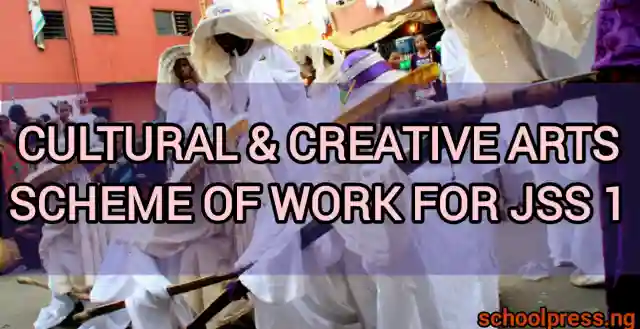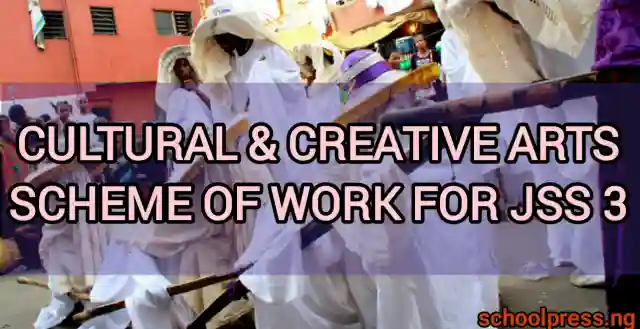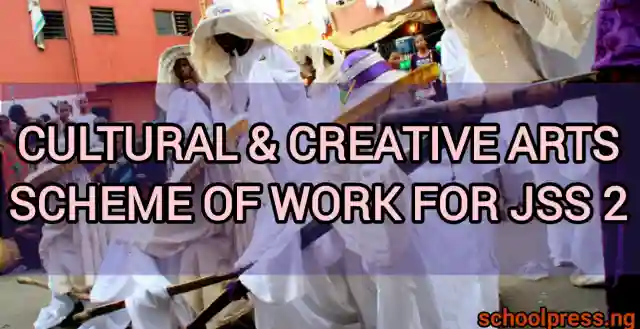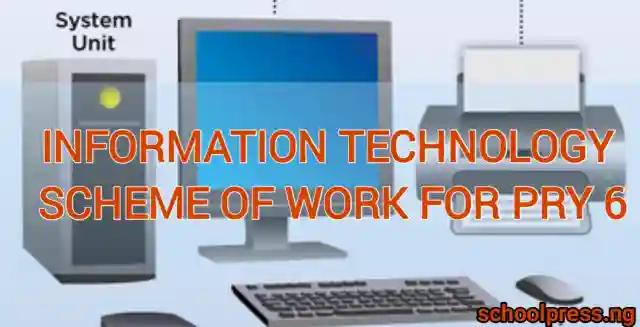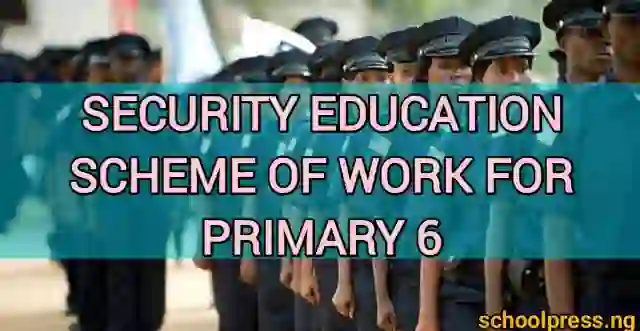Cultural and Creative Arts Scheme of Work for JSS 1 is a comprehensive and varied curriculum that promotes creativity, cultural awareness, and practical skills.
This scheme of work is divided into three terms, each with different topics from drama and music to visual arts and crafts. This foundation will prepare them for further studies and a lifetime of arts appreciation.
The first term covers the duties of a playwright, character development and dialogue writing, the role of a director, casting actors, and overseeing rehearsals.
Costumes and make-up in drama, meaning, uses and expressive qualities, the cultural significance of dance. Principles of choreography and the role of a choreographer.
The second term will cover the theory of music: pitch, melody, harmony, rhythm, texture, timbre, and form. Students develop aural skills and learn the basics of harmony.
They will also learn the music alphabet, types of staves, music notes, and major scales, in order for them to have a solid foundation in music theory.
The students will also cover the use of music: ritual, ceremonial, advertisement, healing, communication, education, entertainment. We learn what is drama and theatre, its functions, elements, forms, origins, playwriting.
Third term first week, the students revise and clear the school compound, from the second week, the students will learn arts, history, origin, and types, including Nigerian art. They will also learn about different types of crafts: fabric, paper mache, carving, weaving, and their cultural and practical uses.
They will also perform practicals on tie and dye, paper craft using folding technique, collage production, paper mache modeling, bead work, mosaics, art materials and tools.
Students make mosaic projects and learn about art materials and provision.
Table of Contents
First Term Cultural and Creative Arts Scheme of Work for JSS 1
| WEEK | TOPIC | CONTENT |
| 1 | Playwright | The duties of playwright: conceives the idea of play. Develop their character through their dialogue and actionsInfuse in Local and situation. Pays attention to the stage directors, transitions, high point etc. |
| 2. | The Director | The play Director: List duties of play directors.He is the boss of the theatreHe coordinates all the other aspects of productionHe casts and rehearses the actors by blocking and guiding their movements |
| 3 | Costume and Make-up in Drama | Meaning of costume: clothing and accessories (caps, shoes, jewelleries) worn by a performer on stageWhat is make-up? Application of all forms of powder and paint on the performertypes of make-up: straight make-up character make-upmake-up items: powder lipstick, wig, eye pencil, native chalk, cam wood etc. |
| 4 | Definition of Dance | Meaning of Dance: Movement of the body in space and time to express an idea or pass across a message.Uses of Dance: Dance entertains, Passes important information and messages like unity, love, tolerance etc. enliven the mood of an occasion etc.How to dance |
| 5. | Introduction to choreography | Meaning of choreography: the art of making and arrangement of dancesPrinciples of choreography: Order, beauty, variety.meaning of choreographer:Theatre artist who creates, arranges, dances, teaches dancers to perform a dance to the delight of an audience |
| 6. | Contemporary Dance | meaning of contemporary dance: A form of dance that is clear departure from the traditional and ballet dance form but draws inspirations from themFeature of contemporary dance: Individual style; creativity does not have fixed movement etc.performing some contemporary dance movements |
| 7. | Team work and sense of belonging | meaning of team workimportance of team workmeaning of sense of belonginghow to achieve sense of belonging |
| 8. | Introduction to Colour | meaning of colouridentify six classes of coloursexplain the properties of colouridentify uses of colourexplain the importance of colour |
| 9. | Drawing | Meaning of drawingtypes of drawing:a. still life drawingb. Nature Drawingc. Figure Drawingd. imaginative drawinge. Seascape drawingf. Abstract drawing |
| 10 and 11 | Consequences of using Fake and Adulterated Goods | Meaning of fake and adulterated goodsGoods that are often faked and adulterated: medicine, processed food, clothing, fabrics etc.Reason why people produce and distribute fake and adulterated goods, Greed, Lack of Patriotism, Disloyalty, Lack of moralsHow to stop the sales of fake and adulterated goods: Be patriotic, show love for your people, Be honest, Resect authority, Know your right as a consumerGovernment Agencies that fight the production and distribution of fake and adulterated goods. NAFDAC, SON, NDLEA |
| 12 | REVISION | |
| 13 | EXAMINATION |
Check All Primary Schemes of Work Below
Second Term Cultural and Creative Arts Scheme of Work for JSS 1
| WEEK | TOPIC | CONTENT |
| 1 | Theory of Music: Fundamentals of Music | Definition: Theory of Music: The study of music in its entirety, how music works with language and notation, and elements of music.Fundamentals of music: Pitch, Melody, Harmony, Rhythm, Texture, Timbre, Quality, Form or Structure.Notes on the Keyboard |
| 2. | EAR TRAINING AND HARMONY | ear training which is aural skills or ability to recognize music other than notationRudiments of harmony in two past writing and four part writing |
| 3. | RUDIMENTS OF MUSIC | Music alphabet. define names of the staves ii. Types of staff, Treble, Bass, Great stave Music notes and their relative values Major scale of natural. Definition, application |
| 4 | PLAYING AN INSTRUMENT (RECORDER) | i. The recorder: this is an instrument in the wood-wing family that come in soprano, alto and tenor versions. ii. Uses of recorder: Good for music, beginners, useful for sight reading and developing listening skills iii. Key signatures of a recorder iv. steps of playing the recorder |
| 5. | USE OF MUSIC | Uses of music: for ritual purpose and for ceremonial purpose, advertisement, healing, work, communication, education, sport etc.impact of music in the society:a. during important occasions b. at joyous momentsc. creating employment |
| 6. | DEFINITION OF DRAMA AND THEATRE | Definition of drama: Type of literature usually written to be performed. Also animation of an action, e.g. Trials of Brother Jero and The Lion and The Jewel by wole Soyinka, etc.Theatre is the performance as well as the place where performance take placepeople involved in drama/theatre like: Play Wright Director Actor Designers Audience etc. |
| 7 | FUNCTIONS OF DRAMA | Functions of drama: a. Education (teaching values among other things b. Information c. Entertainment d. Therapeutic e. Development |
| 8 | ELEMENT OF DRAMA | Elements of drama a. Script/improvisation (plot, dictation)b. Charactersc. stage settingd. audiencee. sound (songs, music, sound effect) f. Lights effects ii. Identifying element in drawing creating element in drama |
| 9 | FORMS OF DRAMA | Forms of drama comedy and tragedy |
| 10 | ORIGIN OF DRAMA | i. Origin of drama: Drama is said to have originated from three sources: mimesis, Ritual and Story Telling. ii. Dramatic element of festivals, Story-Telling: Dialogue, Action Audience, stage etc. |
| 11 | PLAY WRITING | Play writing categories of dramatists/playwright-Classic (universal), modern, contemporary |
| 12 | REVISION | |
| 13 | EXAMINATION |
Check All Jss Scheme Of Work Bellow
Third Term Cultural and Creative Arts Scheme of Work for JSS 1
| WEEK | TOPIC | CONTENT |
| 1 | REVISION AND CLEARING OF THE SCHOOL COMPOUND | cleaning of school compoundrevision of previous work |
| 2 | INTRODUCTION TO ARTS, HISTORY, ORIGIN AND TYPES | Definition of ArtsHistory and Origin of ArtsEarly manNigerian ArtsCategories/Types of Art:a. Textile designb. Ceramicsc. Graphics designd. Aesthetics (Beautification and Decoration) |
| 3 | TYPES OF CRAFTS | Meaning of craftsTypes of craftsa. Fabric craft like woven cloth, tie and dyeb. Paper Machec. carving craft like sculptured. Woven craft like iron window Iron Gate etc.Examples of types of craft:Fabric tie and dyePaper-kite, paper MacheMoulded craft-VasesCarving wood, Calabashwoven-basketUses of crafts Beautification, Culture |
| 4 | PRACTICAL WORKS IN TIE AND DYE USING DIFFERENT METHOD | i. Meaning of tie and dye ii. Methods of tying: a. Tying b. clamping C. folding iii. Materials and tools for tie and dye: a. Fabric b. Dye pigment c. chemical (caustic soda, hydrochloride) d. plastic books e. gloves f. wooden sticks iv. preparation of dye bath Dying process |
| 5 | PAPER CRAFT USING FOLDING TECHNIQUE | i. Meaning of paper craft ii. Materials and tools for making paper craft iii. Methods of folding in paper craft making: Square, Triangular fold, Rectangular, Pleating iv. Paper craft production e.g. Kite, Greeting card, Hand fan. |
| 6. | COLLAGE PRODUCTION | Meaning of collageMaterials for collage e.g. Coloured magazine, scissors, paper gum, card board, drawing book, pencil,. 3.method of producing collage |
| 7 | MODELLING WITH PAPER MACHE | Meaning of paper Mache/clay.materials made from lay and paper Mache e.g. household utensils such as plates, cup decorations, vases, wall hangings, moulded animals e.t.cprocesses of modelling using clay/ paper Machepaper Mache preparationusing paper Mache to mould an object |
| 8 | BEAD WORK | Definition of bead workProduction of bead jewellery. Using: Beads, Roll paper, Seeds, Straw, Small tops etc.Uses of beaded Jewelleries |
| 9 | MOSAICS | Meaning of mosaicMaterials/Tools for making mosaicsUses of mosaics e.g. Jewellery, flower, vases, greeting cards wall hanging.making of mosaics projects |
| 10 | ART MATERIALS | Meaning of Art materials Importance of art ,materialsProvision of some art materials |
| 11. | ART TOOLS AND IMPROVISATION | i. Meaning of art tools ii. Examples of some art tools iii. Uses of art tools iv. Examples of some improvised tools |
| 12 | REVISION | |
| 13 | EXAMINATION |
Check All SSS Scheme Of Work Bellow
Conclusion
Cultural and Creative Arts is a vital subject for Junior Secondary School 1 (JSS 1) students, fostering creativity, cultural awareness, and practical skills.
The curriculum is designed to provide students with a broad understanding and appreciation of various art forms, their historical contexts, and their practical applications.

